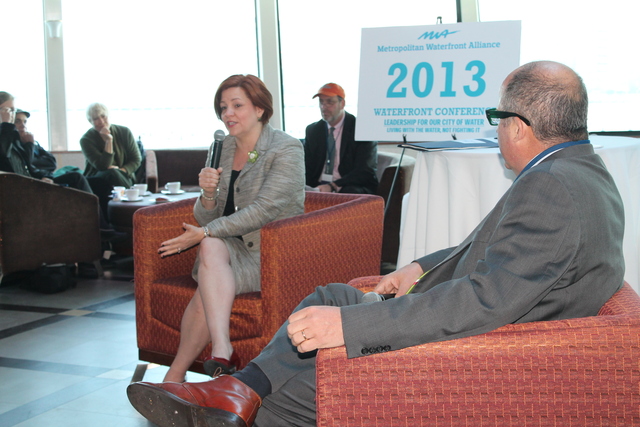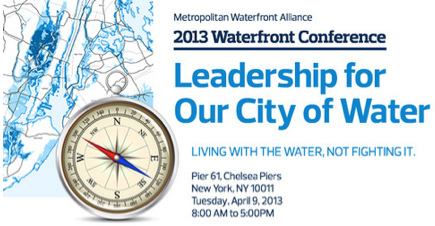On April 9, over 600 people attended the Metropolitan Waterfront Alliance’s (MWA) Conference, “Leadership for Our City of Water: Living with the Water, not Fighting It.” The conference was held at Pier 40 in Hudson River Park aboard the Hornblower Infinity. Among these 600 people were six of the mayoral candidates, who laid out their visions for the future of New York City’s waterfront. There were common views amongst all the candidates: all saw the waterfront as an important city resource, and all wanted a return to a “working waterfront.” Concerns about equitable rebuilding post-Sandy were frequently expressed, while the means by which to pay for it was more unclear. All of the candidates spoke in favor of expanding ferry service between the five boroughs, and many mentioned using a metro card swipe to pay for a ferry ride.
City Council Speaker Christine Quinn was the first candidate to speak in a series of one-on-one discussions moderated by Christopher Ward, MWA Chairperson. Quinn pledged, “I will be a waterfront mayor” and strongly stated that New Yorkers can “still live near the water–we can’t hide from it.” She discussed focusing on hard and soft infrastructure changes, expanding Staten Island’s Blue Belt system, and researching sea walls as storm protection solutions. Quinn cautioned that “every community is different [and] would require a different response” when asked about Governor Cuomo’s buyout programs for affected areas. She emphasized developing the Brooklyn waterfront as a resource especially for its employment potential. If elected mayor, Quinn would appoint a Deputy Mayor of the waterfront, but stop short of creating a Department of the Waterfront.

Public Advocate Bill de Blasio was the next candidate to outline his vision for the waterfront. He emphasized using the federal aid from Hurricane Sandy as an opportunity to correct economic injustices. De Blasio described the placement of NYCHA Housing in environmentally vulnerable areas as “systematic decisions to isolate poor people,” and called for larger investments to address these problems. When asked about PlaNYC 2030, Bloomberg’s sustainability plan, De Blasio said he would continue to follow it as mayor. De Blasio is an advocate for a “holistic ferry system” that would be integrated into all five boroughs, and he would use federal aid to pay for the majority of the cost. De Blasio also described Governors Island as “even more central to the recreational and educational possibilities of our city in the next ten to fifteen years.”
Former City Comptroller Bill Thompson spoke of “working with the community to build better and smarter” in the wake of Hurricane Sandy. He outlined his waterfront vision including niche businesses, parks combined with affordable housing and amenities, and using the waterfront as a learning tool for non-profits and schools. He emphasized the development opportunities along the Brooklyn waterfront, but cautioned that every area is different and there would not be just one solution. Thompson said he would create a comprehensive plan to address various areas, establish timetables, align resources, and communicate with communities. He proposed establishing a commuter tax and using weight based registration fees to raise funds in order to expand and integrate ferries into the larger mass transit system.
John Liu, the current City Comptroller, spoke next about his vision of “reclaiming the waterfront for people who live here now and newcomers alike.” He supports restoring the smaller waterways, such as the Gowanus Canal and Flushing Creek, as well as returning to a working waterfront. Liu is an advocate for integrating ferries throughout the boroughs, a cross-harbor freight tunnel, and potentially using Liberty Island as a multi-ferry station. If elected mayor, Liu would integrate water transportation issues into the Department of Transportation rather than create a new department. He emphasized sustainable growth and his desire to “restore New York City as a world class city.”
John Catsimatidis, the CEO of the Red Apple Group and Gristedes Foods, described himself as the best mayoral candidate for the waterfront because he is the “only candidate with investments in the waterfront.” He emphasized the need to increase funding to attract more cruise ships and draw tourists from the ships into the city. Catsimatidis is also an advocate for using Liberty Island as a terminal to connect tourists with the transit system, but he is also in favor of using Ellis or Governors Island. His overarching vision for NYC is to continue to improve upon existing conditions to prevent backsliding into the past.
The last mayoral candidate to speak was Adolfo Carrion, Jr, the Bronx Borough President. He touted his record for improving the waterfront in the Bronx by rebuilding piers and increasing public access in Hunts Point. He is an advocate for creating a Department of the Waterfront to have a “new platform for waterfront issues across the five boroughs.” He emphasized working with the Department of City Planning, and said “people need to have a real voice in how we grow.”
The moderator and Metropolitan Waterfront Alliance Chairperson Christopher Ward described his initial reactions to the mayoral candidate’s platforms. He was impressed that six candidates attended, and cited Hurricane Sandy for placing waterfront development squarely in the public eye. Ward also called for more detailed and structured plans to guide development along Brooklyn’s waterfront and for the proposed freight tunnel. Ward’s critiques concerned the specificity of the candidates’ plans: Who will pay? How will these visions become reality? With just over six months to go until Election Day, the mayoral candidates have shown their “broad strokes and vision,” according to Ward, but the nuts and bolts of financing, balancing public-private partnerships, and implementation remain to be seen.
